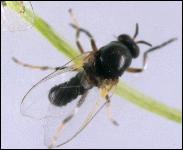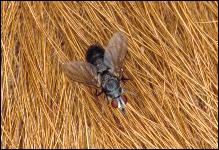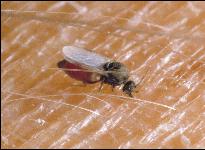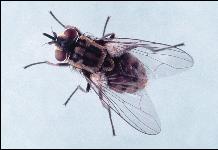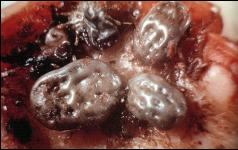
|
|||||||||||||||||||||||||||||||||||||||||||||||||||||||||||||||||||||||||||||||||||||||||||||||||||||||||||||||||||||||||||||||||||||||||||||||||||||||||||||||||||||||||||||||||||||||||||||||||||||||||||||||||||||||||||||||||||||||||||||||||||||||||||||||||||||||||||||||||||||||||||||||||||||||||||||||||||||||||||||||||||||||||||||||||||||||||||||||||||||||||||||||||||||||||||||||||||||||||||||||||||||||||||||||||||||||||||||||||||||||||||||||||||||||||||||||||||||||||||||||||||||||||||||||||||||||||||||||||||||||||||||||||||||||||||||||||||||||||||||||||||||||||||||||||||||||||||||||||||||||||||||||||||||||||||||||||||||||||||||||||||||||||||||||||||||||||||||||||||||||||||||||||||||||||||||||||||||||||||||||||||||||||||||||||||||||||||||||||||||||||||||||||||||||||||||||||||||||||||||||||||||||||||||
| Major Activities :: Pest Management :: Cattle | Home | ||||||||||||||||||||||||||||||||||||||||||||||||||||||||||||||||||||||||||||||||||||||||||||||||||||||||||||||||||||||||||||||||||||||||||||||||||||||||||||||||||||||||||||||||||||||||||||||||||||||||||||||||||||||||||||||||||||||||||||||||||||||||||||||||||||||||||||||||||||||||||||||||||||||||||||||||||||||||||||||||||||||||||||||||||||||||||||||||||||||||||||||||||||||||||||||||||||||||||||||||||||||||||||||||||||||||||||||||||||||||||||||||||||||||||||||||||||||||||||||||||||||||||||||||||||||||||||||||||||||||||||||||||||||||||||||||||||||||||||||||||||||||||||||||||||||||||||||||||||||||||||||||||||||||||||||||||||||||||||||||||||||||||||||||||||||||||||||||||||||||||||||||||||||||||||||||||||||||||||||||||||||||||||||||||||||||||||||||||||||||||||||||||||||||||||||||||||||||||||||||||||||||||||
External Parasites of Dairy CattleFlies Blood-Sucking Flies Black Flies
Figure 1.Black fly
Horn Flies | |||||||||||||||||||||||||||||||||||||||||||||||||||||||||||||||||||||||||||||||||||||||||||||||||||||||||||||||||||||||||||||||||||||||||||||||||||||||||||||||||||||||||||||||||||||||||||||||||||||||||||||||||||||||||||||||||||||||||||||||||||||||||||||||||||||||||||||||||||||||||||||||||||||||||||||||||||||||||||||||||||||||||||||||||||||||||||||||||||||||||||||||||||||||||||||||||||||||||||||||||||||||||||||||||||||||||||||||||||||||||||||||||||||||||||||||||||||||||||||||||||||||||||||||||||||||||||||||||||||||||||||||||||||||||||||||||||||||||||||||||||||||||||||||||||||||||||||||||||||||||||||||||||||||||||||||||||||||||||||||||||||||||||||||||||||||||||||||||||||||||||||||||||||||||||||||||||||||||||||||||||||||||||||||||||||||||||||||||||||||||||||||||||||||||||||||||||||||||||||||||||||||||||||
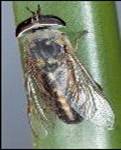 |
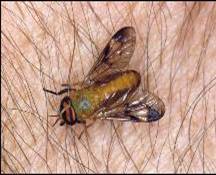 |
Figure 3. Horse fly |
Figure 4. Deer fly |
Tabanids introduce an anticoagulant into the wound when they bite that causes blood to ooze. These wounds are excellent sites for secondary invasion of other insects and diseases, and also cause more blood loss. Being intermittent feeders, they can be important mechanical transmitters of diseases such as anthrax, tularemia and anaplasmosis.
Most species of tabanids are aquatic or semi-aquatic in the immature stage, but some develop in moist soil, leaf mold or rotting logs. Generally the eggs are deposited in layers on vegetation, objects over water, or moist areas favorable to larval development. Eggs hatch in 5 to 7 days and the larvae fall to the surface of the water or moist areas where they begin to feed on organic matter.
Many species prey upon insect larvae, crustacea, snails and earthworms. When the larvae are ready to pupate, they move into drier soil, usually an inch or two below the surface. The pupal stage lasts 2 to 3 weeks, after which the adults emerge. The life cycle varies considerably between species, requiring anywhere from 70 days to 2 years. Florida has more than 122 kinds of horse and deer flies with some species present most times of the year. They are difficult pests to control. Daily mist applications will protect animals, but are difficult for most cattlemen to implement.
Sand Flies and Biting Midges
Sand flies (Figure 5) are small biting flies, also known as punkies, no-see-ums or biting midges. All these flies breed in wet or aquatic habitats and are a difficult, almost impossible, pest to control. These flies are predominately a source of annoyance and irritation, but may also cause suffocation because of large numbers. One species is a known vector of blue tongue virus in cattle and some are intermediate hosts of helminths. Little is known of the life cycle of those attacking livestock.
Figure 5. Sand fly
Stable Flies
The stable fly (Figure 6), or dog fly, is similar to the house fly in size and color, but the bayonet-like mouthparts of the stable fly differentiate it from the house fly. Unlike the flies previously discussed, both sexes of the stable fly are vicious biters. They are strong fliers and range many miles from their breeding site.
Figure 6. Stable fly
Stable flies cause irritation and weakness in animals and account for much blood loss in severe cases. Bite wounds also can serve as sites for secondary infection. These flies are easily interrupted in feeding and are mechanical transmitters of anthrax and anaplasmosis.
Stable flies breed in soggy hay, grain or feed, piles of moist fermenting weed or grass cuttings, spilled green chop, peanut litter and sea weed deposits along beaches and in manure mixed with hay. The female, when depositing eggs, will often crawl into loose material, placing the eggs in little inner pockets. Each female may lay a total of 500 to 600 eggs in 4 separate layings. Eggs hatch in 2 to 5 days and the newly emerged larvae bury themselves, begin to feed, and mature in 14 to 26 days. While the average life cycle is 28 days, this period will vary from 22 to 58 days, depending on weather conditions.
Adult flies are capable of flying up to 80 miles from their breeding site. Greater than 10 flies per animal is considered economically damaging. Higher numbers indicate heavy fly breeding in the area.
Stable fly control is most successfully approached with cultural control measures. Since the larvae require a moist breeding media, it is essential that they breeding source be found and dispersed to allow drying. Animal treatments are limited to fogging or mist applications of insecticide.
Non-Blood-Sucking Flies
Cattle Grubs
Two species of cattle grubs are found in the United States, the common cattle grub and the northern cattle grub. The common cattle grub is found in Florida; however, the northern cattle grub is usually found only in cattle shipped into Florida from other states.
The common cattle grub (Figure 7) lays its eggs chiefly on the hair of cattle, attaching 5 to 15 eggs to a single hair. No pain is inflicted at the time of oviposition. In the spring (February, March, April, May) cattle gallop madly for water or shade to escape the northern cattle grub (gadding). It is apparently a reaction to the sound produced by the bee-like fly in flight.
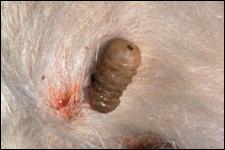
Figure 7. Cattle grub
Eggs hatch within 4 days, and the maggots burrow through the skin. Migration of the first stage larvae of the common cattle grub is through connective tissue, assisted by enzyme secretion. Common cattle grub larvae locate in the mucous membrane of the gullet. Larvae of the northern cattle grub locate in the spinal cord. During the early fall in Florida (October-November), migrating first stage larvae begin reaching the backs of cattle where they cut or digest a breathing hole through the skin and form a warble.
First stage larvae molt in the warble formed in the back to the second stage in 3 to 4 days. The second stage larvae molts to the third stage then grows rapidly, feeding on pus, necrotic cells and secretions from the wall of the warble or cyst. One to 2 months are spent in the warble to attain full larval growth. The grub then squeezes through the breathing hole in the skin and drops to the ground to pupate. Pupation occurs in 2 to 3 days with the pupal stage lasting 20 to 60 days, depending on the temperature. The complete life cycle requires about a year.
The larvae produce two types of injury. First there is irritation caused by larval migrations in the body of the host and later by emergence from beneath the skin. Second, the escape of the larva from the warble leaves an open, running wound that is persistent and subject to secondary infection.
Economic losses are, however, much more important. Milk production may be reduced as much as 10 to 20 percent and loss of weight resulting from the wild efforts of the animals to escape from the flies may be considerable. The value of the carcass depreciates because flesh becomes greenish-yellow and jellylike in appearance and unfit for consumption where the grubs are located. The value of the hide is also reduced because of the holes cut in the skin.
Timing of treatments for control is important. The grubs must be killed before they reach the gullet or spinal cord, because killing grubs in these areas can cause swelling and possibly paralysis or death. "Cut-off dates" have been established in the United States for grub treatment. In Florida, grub appearance in the backs or gullets of animals occurs early, so the "cut-off date" has been set at August 31.
The treatment period includes that time after which egg hatch has ceased until larvae have moved up to, but not into, the back or gullet region. Sprays, dips, feed additives, and pour-ons are all recommended for cattle grub control although pour-ons give best results.
Infestations of Fly Maggots (Myiasis)
Myiasis is the presence of fly larvae in the living tissue of the host. Several kinds of maggots infest the wounds of warm-blooded animals; however, the only one that feeds exclusively on live flesh is the primary screwworm. Sterile male releases have eradicated the primary screwworm fly from the Southeast; but there is constant danger of reinfestation.
Other species such as the secondary screwworm and other blow flies may also infest wounds. These species normally lay their eggs on carcasses of dead animals and may occasionally occur in the dead tissue of open wounds. Although these species may cause some damage, they will not consume living flesh and will feed on dead flesh and wound secretions. However, they may cause some tissue to die and then will feed on this dead tissue.
There is no simple way to differentiate between primary screwworms and other fly larvae. Any suspected screwworm case should be reported to the County Extension Director. Samples of eggs and maggots should be saved in a small container filled with 70% alcohol. Wounds should be treated with insecticidal ointment, sprays or dusts.
Lice
Most lice are permanent ectoparasites, spending their entire lives on the host. Both immature and adult stages are parasitic; therefore, they must remain on their hosts to survive. Each species of louse prefers a certain host. While a species may occur on several breeds of cattle, that same species will not occur on swine or horses. Most sucking lice are specific to the site they occupy on the host.
Five kinds of sucking lice (Figure 8) and one biting louse (Figure 9) are found on cattle in Florida. Sucking lice which feed on blood include the long-nosed cattle louse (found on the head, neck and brisket during winter to early spring), the short-nosed cattle louse (found on the head, neck and brisket during winter to early spring), and the cattle tail louse (the adults found principally in the tail brush and the immatures found on various parts of the body during summer to late fall and sometimes year round). The only biting louse, the cattle biting louse, feeds on skin and hair, causing itching, irritation and hair loss. It can be a severe problem in fall, winter or spring. Lice populations vary seasonally, depending largely on the condition of the host. The biting louse, and most sucking lice begin to increase in number during the fall and reach peak populations in late winter or early spring. Summer populations are usually minimal, causing no obvious symptoms. The host's "climate" may be extremely important. For example, skin temperature and moisture, quantity or thickness of hair, the amount of oil on the skin, and grooming behavior of the host may appreciably affect the size of the louse population. An animal under stress will usually support a larger louse population than is normal.
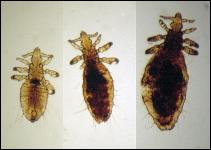 |
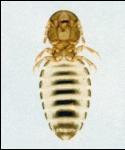 |
Figure 8. Long-nosed cattle louse |
Figure 9. Biting louse |
Lice are generally transmitted from one animal to another by contact. Transmission from herd to herd is usually accomplished by introduction of carrier animals, although some lice may move from place to place by clinging to flies (phoresy).
Feeding lice irritate host animals, and infestations may be recognized by animal behavior. Sucking lice pierce the host's skin and draw blood. Biting lice have chewing mouthparts and feed on particles of hair, scab and skin exudations. The irritation from louse-feeding causes animals to rub and scratch, producing raw areas on the skin or loss of hair. Weight loss may occur as a result of nervousness and improper nutrition. The host often is listless. In severe cases, blood loss to sucking lice can lead to anemia and may produce abortion.
Female lice glue their eggs to the hair of the host, close to the skin. The eggs hatch in 8 to 12 days, depending on the species and temperature. The nymphs go through 3 stages and are fully developed in about 3 weeks. The usual time from egg to egg-laying adult will be about 25 to 28 days.
Control of louse infestations is needed whenever an animal scratches and rubs to excess. Louse control is difficult since pesticides do not kill the louse egg. Since eggs of most species will hatch 8 to 12 days after pesticide application, retreatment is necessary 2 weeks after the first pesticide application. To prevent introduction of new louse infestations care should be taken to treat any new animal introduced into the herd.
Cattle tail lice are a special problem because eggs can survive and hatch up to 40 days after oviposition. A 3-week interval between treatments is recommended so most eggs will have hatched by the time the second application is made. The cattle tail louse (Figure 10) is a problem in the summer and fall seasons.
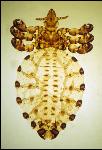
Figure 10. Cattle tail louse
The best control of lice is accomplished with forced use of dust bags. Residual sprays, dips and pour-on materials may also give satisfactory control.
Mites
Mites have the abdomen broadly joined to the thorax with little or no evidence of segmentation. Adults and nymphs generally have 8 legs and the larval stage has 6. The life cycle of many species requires less than 4 weeks and in some it is as short as 8 days. All but a few species of mites are minute and barely visible to the naked eye.
Itch and mange mites (Figure 11) (Psoroptes, Sarcopte, and Chorioptes) feed on the surface or burrow just beneath the skin, making very slender, winding tunnels from 0.1 to 1 inch long. The fluid discharged at the tunnel openings dries to form nodules. A toxin is also secreted which causes intense irritation and itching. Infested animals rub and scratch continuously, often producing inflamed areas with only scattered hairs remaining. The infection may spread over the entire body, forming large, cracked scabs on the thickened skin. Infestations are contagious and treatment of all animals in a herd is essential in preventing spread.
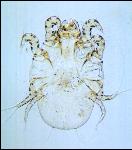
Figure 11. Itch mite
Follicular mites are microscopic, cigar-shaped, worm-like organisms that live within the skin. All stages of the life cycle are found within the hair follicle. The mite causes nodular lesions in the skin which sometimes break, producing holes in the hide and opening the skin to secondary infection. Control is difficult because of the depth of penetration of the mites.
Mosquitoes
Mosquitoes (Figure 12) are small insects with piercing-sucking mouthparts, and scales on their wings. Female mosquitoes suck blood but do not always need blood to lay the first batch of eggs. Several species of mosquitoes attack livestock causing painful bites, unthriftiness, and occasionally death by suffocation or heavy blood loss. In addition, their attacks can cause loss of weight and decreased milk production.
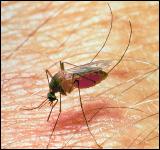
Figure 12. Mosquito
The mosquito life cycle consists of 4 stages. The eggs are laid either directly on the water surface or on damp soil and sides of containers that will be flooded later. Common breeding sites for mosquitoes are drainage ditches, ponds, tin cans, old tires and tree holes. The eggs of most species hatch in 2 to 3 days, and the larvae or "wigglers" feed in the water on organic matter. The larvae pass through 4 stages in about 7 to 10 days. The pupal stage lasts 2 to 3 days, and the adult emerges from the pupal skin at the water surface.
If mosquitoes are a serious problem to livestock in your area, control measures should be implemented. The most effective control method available is source reduction by removing or draining mosquito breeding sites. Daily fogging or aerosoling for adult mosquitoes may provide relief but only as temporary control measure.
Ticks
Ticks (Figure 13) are easily distinguished from insects, since the body is not definitely divided and the strong fusion of the thorax and abdomen produces a sac-like, leathery appearance. A distinct head is lacking, but there is a head-like structure which bears recurved teeth that are inserted into the wound, allowing the tick to hold on strongly. Females can be greatly distended and are bean-like in form when fully engorged. Ticks have 4 developmental stages: egg, 6-legged seed or larval stage, 8-legged nymphal stage and 8-legged adult.
Figure 13. Ear ticks feeding.
A fully engorged female usually deposits eggs (from 100 to 18,000) on the ground. The larval or seed ticks emerging from eggs in the soil usually climb up grasses or other low vegetation to contact passing animals. The larvae molt into nymphs and go through 3 to 5 nymphal stages (soft ticks 2-5). Ticks (Figure 14) remain in the 8-legged form in both nymphal and adult stages. The majority drop off the host to molt after feeding. Males, females and immatures all feed on blood and lymph.

Figure 14. Lone Star tick
The effects of ticks upon the host include inflammation, itching and swelling at the bite site, blood loss, production of wounds that may serve as sites for secondary invasion, obstruction of body openings and paralysis from the injection of toxic fluids. They also transmit many diseases, including anaplasmosis, bovine piroplasmosis and tularemia. Some ticks have the ability to transmit diseases to their offspring without feeding on a diseased animal.
Tick control may be attempted through premise control with insecticides. Premise control kills ticks which are either engorged or on foliage waiting to contact a host. On animals, tick control is best achieved with insecticide sprays or dips.
Keys to Pesticide Safety
- Before using any pesticide, stop and read the precautions.
- Read the label on each pesticide container before each use. Heed all warnings and precautions.
- Store all pesticides in their original containers away from food or feed.
- Keep pesticides out of the reach of children, pets and livestock.
- Apply pesticides only as directed.
- Dispose of empty containers promptly and safely.
Recommendations in this guide are for guidelines only. The user must insure that the pesticide is applied in strict compliance with label directions.
The Food and Drug Administration has established residue tolerances for certain insecticides in the meat of certain animals. When these and other approved insecticides are applied according to recommendations, the pests should be effectively controlled and the animals' products will be safe for food.
The improper use of insecticides may result in residue in milk or meat. Such products must not be delivered to processing plants. To avoid excessive residues, use the insecticides recommended at the time recommended and in the amounts recommended.
Tables
Table 1.Summary of Dairy Cattle Insecticide Registrations.
Insecticide |
Formulation | % Active Ingredient |
Signal Word |
Dairy Animal Usage | Pests |
| Beta-cyfluthrin (CyLence Ultra) |
Ear Tag | 8.0% | Caution | Non-lactating | horn flies, Gulf Coast ticks, Spinose ear ticks (Reg 06/05) |
| Coumaphos (Co-Ral Emulsifiable Livestock Insecticide) |
Emulsifiable Concentrate | 11.6% | Danger | All | horn flies, lice, ticks(Reg 06/05) |
| (Co-Ral Fly and Tick Spray) | Emulsifiable Concentrate | 6.15% | Warning | All | horn flies, lice, ticks(Reg 06/05) |
| (Co-Ral Plus) | Ear Tag | 20.0% | Caution | Non-lactating | Gulf Coast ticks, horn flies, Spinose ear ticks (Reg 06/05) |
| Cyfluthrin (Cutter Gold) |
Ear Tag | 10.0% | Caution | All | Gulf Coast ticks, horn flies, Spinose ear ticks (Reg 06/05) |
| (CyLence) | Pour-On | 1.0% | Warning | All | horn flies, lice (Reg 06/05) |
| Diazinon (Cutter 1) |
Ear Tag | 40.0% | Warning | Non-lactating | Gulf Coast ticks, horn flies, Spinose ear ticks (Reg 06/05) |
| (Optimizer) | Ear Tag | 21.4% | Warning | Non-lactating | Gulf Coast ticks, horn flies, lice, Spinose ear ticks (Reg 03/06) |
| (Patriot) | Ear Tag | 40.0% | Warning | Non-lactating | ear ticks, horn flies(Reg 06/07) |
| Diazinon + Chlorpyrifos (Warrior) |
Ear Tag | 30.0% + 10.0% | Warning | Non-lactating | Gulf Coast ticks, horn flies, lice, Spinose ear ticks (Reg 03/06) |
| Ethion (Commando) |
Ear Tag | 36.0% | Warning | All | ear ticks, horn flies(Reg 06/07) |
| Methoprene (Altosid Premix) |
Feed Additive (IGR) | 0.4% | Caution | All | horn flies (Reg 12/05) |
| Moxidectin (Cydectin Pour-On) |
Pour-On | 0.50% | All | cattle grugs, horn flies, lice | |
| Permethrin (Atroban 11% EC Insecticide) |
Emulsifiable Concentrate | 11.0% | All | black flies, eye gnats, horn flies, horse flies, house flies, lice, mange mites, mosquitoes, scabies mites, stable flies, ticks (Reg 06/07) | |
| (Atroban 42.5%) | Emulsifiable Concentrate | 42.5% | Danger | All | horn flies, horse flies, house flies, lice, mites, mosquitoes, stable flies, ticks (Reg 06/07) |
| (Atroban Delice Pour-On Insecticide) | Pour-On | 1.0% | All | horn flies, lice, mosquitoes, ticks (Reg 06/07) | |
| (Boss Pour-On Insecticide) | Pour-On | 5.0% | All | horn flies, lice (Reg 06/07) | |
| (Brute Insecticide for Cattle) | Ready-To-Use-Liquid | 10.0% | Warning | All | horn flies, lice (Reg 06/06) |
| (Catron IV) | Aerosol | 0.5% | Caution | All | deer flies, horn flies, horse flies, house flies, gnats, screwworms (Reg 06/07) |
| (GardStar 40% EC) | Emulsifiable Concentrate | 40.0% | Danger | All | black flies, deer flies, eye gnats, horn flies, horse flies, house flies, lice, mange mites, mosquitoes, scabies mites, stable flies, ticks (Reg 03/06) |
| (GardStar Plus) | Ear Tag | 10.0% | Caution | All | Gulf Coast ticks, horn flies, Spinose ear ticks (Reg 03/06) |
| (Permectrin II) | Emulsifiable Concentrate | 10.0% | Caution | All | horn flies, horse flies, lice, mites, mosquitoes, stable flies, ticks (Reg 06/07) |
| (Ultra Boss Pour-On) | Pour-On | 5.8% | All | horn flies, lice (Reg 06/07) | |
| Permethrin (Synergized) (Permectrin CDS) |
Pour-On | 7.4% | Caution | All | horn flies, lice (Reg 06/07) |
| (Synergized Delice Pour-On Insecticide) | Pour-On | 1.0% | All | horn flies, lice (Reg 06/07) | |
| Phosmet (Delphos Emulsifiable Liquid) |
Emulsifiable Concentrate | 11.6% | All | Gulf Coast ear ticks, horn flies, lice, Lone Star ticks, sarcoptic mange, winter ticks (Reg 06/07) | |
| (Prolate/Lintox-HD) | Emulsifiable Concentrate | 11.75% | Danger | Non-lactating | horn flies, lice ticks (Reg 12/05) |
| Tetrachlorvinphos (Rabon 7.76 Oral Larvacide Premix) |
Feed Additive | 7.76% | Caution | All | horn flies, house flies, stable flies (Reg 03/07) |
| (Ravap E.C.) | Emulsifiable Concentrate | 23.0% | Danger | All | gnats, horn flies, lice, ticks (Reg 09/06) |
| Zeta-cypermethrin (Python) |
Ear Tag | 10.0% | Caution | All | Gulf Coast ticks, horn flies, lice, Spinose ear ticks (Reg 03/06) |
| (Python Dust) | Dust | Caution | All | horn flies, keds, lice, ticks (Reg 03/06) |
Table 2.Registered Insecticides for Specific Pests of Dairy Cattle.
Insectcide |
Formulation | Re-Treatment Interval |
Comments |
| Black Flies | |||
| Atroban 11% EC Insecticide (permethrin) | Emulsifiable Concentrate | 2 weeks | Mix thoroughly according to label directions. Spray lactating animals only after milking is completed. (Reg 06/07) |
| GardStar 40% EC (permethrin) |
Emulsifiable Concentrate | 10-14 days | Dilute and apply according to label directions. May be used as a high pressure spray, low pressure spray (hand-pump sprayer), or backrubber. (Reg 03/06) |
| Cattle Grubs | |||
| Cydectin Pour-On (moxidectin) | Pour-On | Slowly, apply directly to the hair and healthy skin in a narrow strip extending along the top of the back from the withers to the tailhead. | |
| Deer Flies | |||
| Catron IV (permethrin) |
Aerosol | Spray according to label directions. (Reg 06/07) | |
| GardStar 40% EC (permethrin) |
Emulsifiable Concentrate | 10-14 days | Dilute and apply according to label directions. May be used as a high pressure spray, low pressure spray (hand-pump sprayer), or backrubber. (Reg 03/06) |
| Gnats | |||
| Atroban 11% EC Insecticide (permethrin) | Emulsifiable Concentrate | 2 weeks | Mix thoroughly according to label directions. Spray lactating animals only after milking is completed. (Reg 06/07) |
| Catron IV (permethrin) |
Aerosol | Spray according to label directions. (Reg 06/07) | |
| GardStar 40% EC (permethrin) |
Emulsifiable Concentrate | 10-14 days | Dilute and apply according to label directions. May be used as a high pressure spray, low pressure spray (hand-pump sprayer), or backrubber. (Reg 03/06) |
| Horn Flies | |||
| Altosid Premix (methoprene) |
Feed Additivive (IGR) | Begin use in the spring before horn flies appear on cattle and continue feeding until cold weather restricts horn fly activity. Mix with feed or minerals at the rate recommended on the label. (Reg 12/05) | |
| Atroban 11% EC Insecticide (permethrin) | Emulsifiable Concentrate | 2 weeks | Mix thoroughly according to label directions. Spray lactating animals only after milking is completed. (Reg 06/07) |
| Atroban 42.5% EC (permethrin) | Emulsifiable Concentrate | 10 to 14 days | Apply diluted product, according to label directions as a dip or spray. Do not use in milk rooms. (Reg 06/07) |
| Atroban Delice Pour-On Insecticide (permethrin) |
Pour-On | 2 weeks | Ready to use - No dilution necessary. Apply according to label directions. (Reg 06/07) |
| Boss Pour-On Insecticide (permethrin) | Pour-On | 2 weeks | Pour proper amount along back and down face. (Reg 06/07) |
| Brute Pour-On for Cattle (permethrin) | Ready-To-UseLiquid | 2 weeks | Apply according to label directions. (Reg 06/06) |
| Catron IV (permethrin) |
Aerosol | Spray according to label directions. (Reg 06/07) | |
| Commando (ethion) |
Ear Tag | As necessary | One tag to each ear. Do not tag calves less than 3 months of age. Aids in control of house flies, lice and stable flies. (Reg 06/07) |
| Co-Ral Emulsifiable Livestock Insecticide (coumaphos) |
Emulsifiable Concentrate | Repeat as necessary. | Apply diluted product as a spray or backrubber, acording to label directions. Suspend backrubber at a height that will prevent straddling. (Reg 06/05) |
| Co-Ral Fly and Tick Spray (coumaphos) | Emulsifiable Concentrate | Not less than 10 days. | May be used as a backrubber for all dairy cattle when hung at a height preventing straddling. Do not apply for 10 days before or after shipping or weaning. Do not apply within 14 days of freshening. If freshening should occur within the interval after spraying, do not use milk for human food for balance of 14 day interval. For non-lactating animals, may be applied as a spray according to specified dosage, wetting to run-off. Do not treat more than six times per year. (Reg 06/05) |
| Cutter Gold (cyfluthrin) |
Ear Tag | As necessary. | All animals in the herd should be tagged. Attach one tag to each ear. Remove tags at the end of fly season. (Reg 06/05) |
| Cydectin Pour-On (moxidectin) | Pour-On | Slowly, apply directly to the hair and healthy skin in a narrow strip extending along the top of the back from the withers to the tailhead. | |
| CyLence (cyfluthrin) |
Pour-On | 3 weeks | Apply the required amount of ready-to-use solution directly along the top of the back and top of head of the animal. (Reg 06/05) |
| Del-Phos Emulsifiable Liquid (phosmet) | Emulsifiable Concentrate | 7-10 days | May be applied as a spray or backrubber. Do not treat non-lactating dairy cattle within 28 days of freshening. If freshening occurs, milk must not be used for human food purposes. (Reg 06/07) |
| GardStar 40% EC (permethrin) |
Emulsifiable Concentrate | 10-14 days | Dilute and apply according to label directions. May be used as a high pressure spray, low pressure spray (hand-pump sprayer), or backrubber. (Reg 03/06) |
| GardStar Plus (permethrin) |
Ear Tag | As necessary | Apply according to label directions. (Reg 03/06) |
| Permectrin II (permethrin) |
Emulsifiable Concentrate | 2 weeks | May be applied as spray or to charge a backrubber. Wash udders thoroughly before milking. (Reg 06/07) |
| Permectrin CDS (permethrin, synergized) |
Pour-On | As needed, but not more than once every two weeks | May be applied as a pour-on, ready-to-use spray, or in a backrubber. Aids in control of black flies, horse flies, house flies, mosquitoes, stable flies and ticks. (Reg 06/07) |
| Python (zeta-cypermethrin) |
Ear Tag | Apply according to label directions. (Reg 03/06) | |
| Python Dust (zeta-cypermethrin) | Dust | Can be applied by dust bag, shaker can, dusting glove and mechanical dust applicator. See label for directions. Caution: Do not use concurrently with insecticide ear tags cotaining zeta-cypermethrin or cypermethrin. (Reg 03/06) | |
| Rabon 7.76 Oral Larvicide Premix (tetrachlorvinphos) |
Feed Additive | Prepare feed according to label directions. (Reg 03/07) |
|
| Ravap E.C. (tetrachlorvinphos) | Emulsifiable Concentrate | 10 days | Dilute in water as indicated. Do not apply to calves under six months of age. Care should be taken that the spray does not come in contact with the lactating dairy cow's teats unless they are washed and dried before milking. Apply the spray at least 20 minutes prior to milking or after milking has been completed. May be applied as a surface spray in dairy barns. (Reg 09/06) |
| Synergized Delice Pour-On Insecticide (permethrin-synergized) | Pour-On | 2 weeks | Apply ready-to-use liquid as pour-on or spray according to label directions. May be used with backrubber. (Reg 06/07) |
| Ultra Boss Pour-On (permethrin) | Pour-On | 2 weeks | May be used as a pour-on or backrubber. (Reg 06/07) |
| Horse Flies | |||
| Atroban 11% EC Insecticide (permethrin) | Emulsifiable Concentrate | 2 weeks | Mix thoroughly according to label directions. Spray lactating animals only after milking is completed. (Reg 06/07) |
| Atroban 42.5% EC (permethrin) | Emulsifiable Concentrate | 10 to 14 days | Apply diluted product, according to label directions as a dip or spray. Do not use in milk rooms. (Reg 06/07) |
| Catron IV (permethrin) | Aerosol | Spray according to label directions. (Reg 06/07) | |
| GardStar 40% EC (permethrin) |
Emulsifiable Concentrate | 10-14 days | Dilute and apply according to label directions. May be used as a high pressure spray, low pressure spray (hand-pump sprayer), or backrubber. (Reg 03/06) |
| Permectrin II (permethrin) |
Emulsifiable Concentrate | 2 weeks | May be applied as spray or to charge a backrubber. Wash udders thoroughly before milking. (Reg 06/07) |
| House Flies | |||
| Atroban 11% EC Insecticide (permethrin) | Emulsifiable Concentrate | 2 weeks | Mix thoroughly according to label directions. Spray lactating animals only after milking is completed. (Reg 06/07) |
| Atroban 42.5% EC (permethrin) | Emulsifiable Concentrate | 10 to 14 days | Apply diluted product, according to label directions as a dip or spray. Do not use in milk rooms. (Reg 06/07) |
| Catron IV (permethrin) | Aerosol | Spray according to label directions. (Reg 06/07) | |
| GardStar 40% EC (permethrin) |
Emulsifiable Concentrate | 10-14 days | Dilute and apply according to label directions. May be used as a high pressure spray, low pressure spray (hand-pump sprayer), or backrubber. (Reg 03/06) |
| Rabon 7.76 Oral Larvicide Premix (tetrachlorvinphos) | Feed Additive | Prepare feed according to label directions. (Reg 03/07) | |
| Lice | |||
| Atroban 11% EC Insecticide (permethrin) | Emulsifiable Concentrate | 2 weeks | Mix thoroughly according to label directions. Spray lactating animals only after milking is completed. (Reg 06/07) |
| Atroban 42.5% EC (permethrin) | Emulsifiable Concentrate | 10 to 14 days | Apply diluted product, according to label directions as a dip or spray. Do not use in milk rooms. (Reg 06/07) |
| Atroban Delice Pour-On Insecticide (permethrin) | Pour-On | 2 weeks | Ready to use - No dilution necessary. Apply according to label directions. (Reg 06/07) |
| Boss Pour-On Insecticide | Pour-On | 2 weeks | Pour proper amount along back and down face. For optimum lice control, two treatments at 14 day intervals are recommended. (Reg 06/07) |
| Brute Pour-On for Cattle (permethrin) | Ready-To-Use Liquid | 2 weeks | Apply according to label directions. (Reg 06/06) |
| Catron IV (permethrin) | Aerosol | 3 weeks, if required | For blood-sucking lice, apply to the infested areas of the animal using a stiff brush to get the spray to the base of the hair. (Reg 06/07) |
| Co-Ral Emulsifiable Livestock Insecticide (coumaphos) | Emulsifiable Concentrate | Repeat as necessary | Apply diluted product as a spray or backrubber, acording to label directions. Suspend backrubber at a height that will prevent straddling. (Reg 06/05) |
| Co-Ral Fly and Tick Spray (coumaphos) | Emulsifiable Concentrate | Not less than 10 days | May be used as a backrubber for all dairy cattle when hung at a height preventing straddling. Do not apply for 10 days before or after shipping or weaning. Do not apply within 14 days of freshening. If freshening should occur within the interval after spraying, do not use milk for human food for balance of 14 day interval. For non-lactating animals, may be applied as a spray according to specified dosage, wetting to run-off. Do not treat more than six times per year. (Reg 06/05) |
| Cydectin Pour-On (moxidectin) | Pour-On | Apply directly to the hair and healthy skin in a narrow strip extending along the top of the back from the withers to the tailhead. | |
| CyLence (cyfluthrin) | Pour-On | 3 weeks | Apply the required amount of ready-to-use solution directly along the top of the back and top of head of the animal. (Reg 06/05) |
| Del-Phos Emulsifiable Liquid (phosmet) | Emulsifiable Concentrate | 7-10 days | May be applied as a spray or backrubber. Do not treat non-lactating dairy cattle within 28 days of freshening. If freshening occurs, milk must not be used for human food purposes. (Reg 06/07) |
| GardStar 40% EC (permethrin) |
Emulsifiable Concentrate | 10-14 days | Dilute and apply according to label directions. May be used as a high pressure spray, low pressure spray (hand-pump sprayer), or backrubber. (Reg 03/06) |
| Permectrin II (permethrin) |
Emulsifiable Concentrate | 2 weeks | May be applied as spray or to charge a backrubber. Wash udders thoroughly before milking. (Reg 06/07) |
| Permectrin CDS (permethrin, synergized) |
Pour-On | As needed, but not more than once every two weeks | May be applied as a pour-on, ready-to-use spray, or in a backrubber. Aids in control of black flies, horse flies, house flies, mosquitoes, stable flies and ticks. (Reg 06/07) |
| Python (zeta-cypermethrin) | Ear Tag | Apply according to label directions. (Reg 03/06) | |
| Python Dust (zeta-cypermethrin) | Dust | Can be applied by dust bag, shaker can, dusting glove and mechanical dust applicator. See label for directions. Caution: Do not use concurrently with insecticide ear tags containing zeta-cypermethrin or cypermethrin. (Reg 03/06) | |
| Ravap E.C. (tetrachlorvinphos) | Emulsifiable Concentrate |
Dilute in water as indicated. Do not apply to calves under six months of age. Care should be taken that the spray does not come in contact with the lactating dairy cow's teats unless they are washed and dried before milking. Apply the spray at least 20 minutes prior to milking or after milking has been completed. May be applied as a surface spray in dairy barns. (Reg 09/06) | |
| Synergized Delice Pour-On Insecticide (permethrin-synergized) | Pour-On | 2 weeks | Apply ready-to-use liquid as pour-on or spray according to label directions. May be used with backrubber. (Reg 06/07) |
| Ultra Boss Pour-On (permethrin) | Pour-On | 2 weeks | May be used as a pour-on or backrubber. (Reg 06/07) |
| Mites | |||
| Atroban 42.5% EC (permethrin) | Emulsifiable Concentrate | 10 to 14 days | Apply diluted product, according to label directions as a dip or spray. Do not use in milk rooms. (Reg 06/07) |
| Permectrin II (permethrin) |
Emulsifiable Concentrate | 2 weeks | May be applied as spray or to charge a backrubber. Wash udders thoroughly before milking. (Reg 06/07) |
| Mites (Mange) | |||
| Atroban 11% EC Insecticide (permethrin) | Emulsifiable Concentrate | 2 weeks | Mix thoroughly according to label directions. Spray lactating animals only after milking is completed. (Reg 06/07) |
| Del-Phos Emulsifiable Liquid (phosmet) | Emulsifiable Concentrate | 7-10 days | May be applied as a spray or backrubber. Do not treat non-lactating dairy cattle within 28 days of freshening. If freshening occurs, milk must not be used for human food purposes. (Reg 06/07) |
| GardStar 40% EC (permethrin) |
Emulsifiable Concentrate | 10-14 days | Dilute and apply according to label directions. May be used as a high pressure spray, low pressure spray (hand-pump sprayer), or backrubber. (Reg 03/06) |
| Mites (Scabies) | |||
| Atroban 11% EC Insecticide (permethrin) | Emulsifiable Concentrate | 2 weeks | Mix thoroughly according to label directions. Spray lactating animals only after milking is completed. (Reg 06/07) |
| GardStar 40% EC (permethrin) |
Emulsifiable Concentrate | 10-14 days | Dilute and apply according to label directions. May be used as a high pressure spray, low pressure spray (hand-pump sprayer), or backrubber. (Reg 03/06) |
| Mosquitoes | |||
| Atroban 11% EC Insecticide (permethrin) | Emulsifiable Concentrate | 2 weeks | Mix thoroughly according to label directions. Spray lactating animals only after milking is completed. (Reg 06/07) |
| Atroban 42.5% EC (permethrin) | Emulsifiable Concentrate | 10 to 14 days | Apply diluted product, according to label directions as a dip or spray. Do not use in milk rooms. (Reg 06/07) |
| Atroban Delice Pour-On Insecticide (permethrin) | Pour-On | 2 weeks | Ready to use - No dilution necessary. Apply according to label directions. (Reg 06/07) |
| GardStar 40% EC (permethrin) |
Emulsifiable Concentrate | 10-14 days | Dilute and apply according to label directions. May be used as a high pressure spray, low pressure spray (hand-pump sprayer), or backrubber. (Reg 03/06) |
| Permectrin II (permethrin) |
Emulsifiable Concentrate | 2 weeks | May be applied as spray or to charge a backrubber. Wash udders thoroughly before milking. (Reg 06/07) |
| Screwworms | |||
| Catron IV (permethrin) | Aerosol | Spray wound thoroughly allowing spray to penetrate into pockets made by maggots. Apply over discharge around wound to prevent reinfestation. Treat at 5 to 7 day intervals until wound is healed. (Reg 06/07) | |
| Stable Flies | |||
| Atroban 11% EC Insecticide (permethrin) | Emulsifiable Concentrate | 2 weeks | Mix thoroughly according to label directions. Spray lactating animals only after milking is completed. (Reg 06/07) |
| Atroban 42.5% EC (permethrin) | Emulsifiable Concentrate | 10 to 14 days | Apply diluted product, according to label directions as a dip or spray. Do not use in milk rooms. (Reg 06/07) |
| Catron IV (permethrin) | Aerosol | Spray according to label directions. | |
| GardStar 40% EC (permethrin) |
Emulsifiable Concentrate | 10-14 days | Dilute and apply according to label directions. May be used as a high pressure spray, low pressure spray (hand-pump sprayer), or backrubber. (Reg 03/67) |
| Permectrin II (permethrin) |
Emulsifiable Concentrate | 2 weeks | May be applied as spray or to charge a backrubber. Wash udders thoroughly before milking. (Reg 06/07) |
| Rabon 7.76 Oral Larvicide Premix (tetrachlorvinphos) | Feed Additive | Prepare feed according to label directions. (Reg 03/07) | |
| Ticks | |||
| Atroban 11% EC Insecticide (permethrin) | Emulsifiable Concentrate | 2 weeks | Mix thoroughly according to label directions. Spray lactating animals only after milking is completed. (Reg 06/07) |
| Atroban 42.5% EC (permethrin) | Emulsifiable Concentrate | 10 to 14 days | Apply diluted product, according to label directions as a dip or spray. Do not use in milk rooms. (Reg 06/07) |
| Atroban Delice Pour-On Insecticide (permethrin) | Pour-On | 2 weeks | Ready to use - No dilution necessary. Apply according to label directions. (Reg 06/07) |
| Co-Ral Fly and Tick Spray (coumaphos) | Emulsifiable Concentrate | 10 days | May be used as a backrubber for all dairy cattle when hung at a height preventing straddling. Do not apply for 10 days before or after shipping or weaning. Do not apply within 14 days of freshening. If freshening should occur within the interval after spraying, do not use milk for human food for balance of 14 day interval. For non-lactating animals, may be applied as a spray according to specified dosage, wetting to run-off. Do not treat more than six times per year. (Reg 06/05) |
| GardStar 40% EC (permethrin) |
Emulsifiable Concentrate | 10-14 days | Dilute and apply according to label directions. May be used as a high pressure spray, low pressure spray (hand-pump sprayer), or backrubber. (Reg 03/06) |
| Permectrin II (permethrin) |
Emulsifiable Concentrate | 2 weeks | May be applied as spray or to charge a backrubber. Wash udders thoroughly before milking. (Reg 06/07) |
| Python Dust (zeta-cypermehtrin) | Dust | Can be applied by dust bag, shaker can, dusting glove and mechanical dust applicator. See label for directions. Caution: Do not use concurrently with insecticide ear tags containing zeta-cypermethrin or cypermethrin. (Reg 03/06) | |
| Ticks (Ear) | |||
| Commando (ethion) | Ear Tag | As necessary | One tag to each ear. Do not tag calves less than 3 months of age. (Reg 06/07) |
| Ticks (Gulf Coast) | |||
| Catron IV (permethrin) | Aerosol | As necessary | Spray directly onto ticks on outer surface of animal's ear. (Reg 06/07) |
| Cutter Gold (cyfluthrin) | Ear Tag | As necessary | All animals in the herd should be taged. Attach one tag to each ear. Remove tags at the end of fly season. (Reg 06/05) |
| Del-Phos Emulsifiable Liquid (phosmet) | Emulsifiable Concentrate | 7-10 days | May be applied as a spray or backrubber. Do not treat non-lactating dairy cattle within 28 days of freshening. If freshening occurs, milk must not be used for human food purposes. (Reg 06/07) |
| GardStar Plus (permethrin) | Ear Tag | As necessary | Apply according to label directions. (Reg 03/06) |
| Python (zeta-cypermethrin) | Ear Tag | Apply according to label directions. (Reg 03/06) | |
| Ticks (Lone Star) | |||
| Del-Phos Emulsifiable Liquid (phosmet) | Emulsifiable Concentrate | 7-10 days | May be applied as a spray or backrubber. Do not treat non-lactating dairy cattle within 28 days of freshening. If freshening occurs, milk must not be used for human food purposes. (Reg 06/07) |
| Ravap E.C.(tetrachlorvinphos) | Emulsifiable Concentrate | 10 days | Dilute in water as indicated. Do not apply to calves under six months of age. Care should be taken that the spray does not come in contact with the lactating dairy cow's teats unless they are washed and dried before milking. Apply the spray at least 20 minutes prior to milking or after milking has been completed. May be applied as a surface spray in dairy barns. (Reg 09/06) |
| Ticks (Spinose Ear) | |||
| Catron IV (permethrin) | Aerosol | As necessary | Spray downward directly into animal's ear. (Reg 06/07) |
| Cutter Gold (cyfluthrin) | Ear Tag | As necessary | All animals in the herd should be taged. Attach one tag to each ear. Remove tags at the end of fly season. (Reg 06/05) |
| GardStar Plus (permethrin) | Ear Tag | As necessary | Apply according to label directions. (Reg 03/06) |
| Python (zeta-cypermethrin) | Ear Tag | Apply according to label directions. (Reg 03/06) | |
| Ticks (Winter) | |||
| Del-Phos Emulsifiable Liquid (phosmet) | Emulsifiable Concentrate | 7-10 days | May be applied as a spray or backrubber. Do not treat non-lactating dairy cattle within 28 days of freshening. If freshening occurs, milk must not be used for human food purposes. (Reg 06/07) |
Table 3.Registered Insecticides for Specific Pests on Non-Lactating Dairy Cattle only.
Insectcide |
Formulation | Re-Treatment Interval |
Comments |
| Horn Flies | |||
| Co-Ral Plus (coumaphos) | Ear Tag | All mature animals in the herd should be tagged. Calves less than 3 months of age should not be tagged. Remove tags at end of fly season. (Reg 06/05) | |
| Cutter 1 (diazinon) | Ear Tag | As necessary | For optimum control attach one tag to each ear. Calves less than 3 months of age should not be tagged. Remove tags prior to slaughter. (Reg 06/05) |
| CyLence Ultra (beta-cyfluthrin) | Ear Tag | As necessary | All mature animals in the herd should be tagged. For optimum control attach one tag to each ear. Calves less than 3 months of age should not be tagged. Remove tags prior to slaughter. (Reg 06/05) |
| Optimizer (diazinon) | Ear Tag | Attach two tags per animal for optimum control. All animals in herd should be tagged. Remove tags at end of fly and lice seasons. (Reg 03/06) | |
| Patriot (diazinon) | Ear Tag | As necessary | Attach one tag to each ear. Do not tag claves less than 3 months of age. Aids in control of house flies, lice and stable flies. Remove tags prior to slaughter. (Reg 06/07) |
| Prolate/Lintox-HD (phosmet) | Emulsifiable Concentrate | 7-10 days as necessary | May be used as spray or with backrubber. Do not use this product on animals simultaneously or within a few days before or after treatment with or exposure to cholinesterase inhibiting drugs, pesticides, or chemicals. Do not treat sick, convalescent, stressed, or animals less than 3 months old. Do not treat non-lactating dairy cattle within 28 days of freshening. If freshening should occur within the 28 day period after treatment, that milk must not be used as human food. (Reg 12/05) |
| Warrior (diazinon + chlorpyrifos) |
Ear Tag | Apply when pests appear. For optimum control, apply 2 tags per animal (1 per ear) for up to 5 months. All animals in the herd should be tagged. Do not tag animals less than 3 months of age. Remove tags prior to slaughter. (Reg 03/06) | |
| Lice | |||
| Optimizer (diazinon) | Ear Tag | Attach two tags per animal for optimum control. All animals in herd should be tagged. Remove tags at end of fly and lice season. (Reg 03/06) | |
| Prolate/Lintox-HD (phosmet) | Emulsifiable Concentrate | 7-10 days as necessary | May be used as spray or with backrubber. Do not use this product on animals simultaneously or within a few days before or after treatment with or exposure to cholinesterase inhibiting drugs, pesticides, or chemicals. Do not treat sick, convalescent, stressed, or animals less than 3 months old. Do not treat non-lactating dairy cattle within 28 days of freshening. If freshening should occur within the 28 day period after treatment, that milk must not be used as human food. (Reg 12/05) |
| Python (zeta-cypermethrin) | Ear Tag | Apply according to label directions. (Reg 03/06) | |
| Warrior (diazinon + chlorpyrifos) |
Ear Tag | Apply when pests appear. For optimum control, apply 2 tags per animal (1 per ear) for up to 5 months. All animals in teh herd should be tagged. Do not tag animals less than 3 months of age. Remove tags prior to slaughter. (Reg 03/06) | |
| Mites | |||
| Warrior (diazinon + chlorpyrifos) |
Ear Tag | Apply when pests appear. For optimum control, apply 2 tags per animal (1 per ear) for up to 5 months. All animals in teh herd should be tagged. Do not tag animals less than 3 months of age. Remove tags prior to slaughter. (Reg 03/06) | |
| Ticks | |||
| Prolate/Lintox-HD (phosmet) | Emulsifiable Concentrate | 7-10 days as necessary | May be used as spray or with backrubber. Do not use this product on animals simultaneously or within a few days before or after treatment with or exposure to cholinesterase inhibiting drugs, pesticides, or chemicals. Do not treat sick, convalescent, stressed, or animals less than 3 months old. Do not treat non-lactating dairy cattle within 28 days of freshening. If freshening should occur within the 28 day period after treatment, that milk must not be used as human food. (Reg 12/05) |
| Ticks (Ear) | |||
| Patriot (diazinon) | Ear Tag | As necessary | Attach one tag to each ear. Do not tag claves less than 3 months of age. Aids in control of house flies, lice and stable flies. Remove tags prior to slaughter. (Reg 06/07) |
| Ticks (Gulf Coast) | |||
| Co-Ral Plus (coumaphos) | Ear Tag | All mature animals in the herd should be tagged. Calves less than 3 months of age should not be tagged. Remove tags at end of fly season. (Reg 06/05) | |
| Cutter 1 (diazinon) | Ear Tag | As necessary | For optimum control attach one tag to each ear. Calves less than 3 months of age should not be tagged. Remove tags prior to slaughter. (Reg 06/05) |
| CyLence Ultra (beta-cyfluthrin) | Ear Tag | As necessary | All mature animals in the herd should be tagged. For optimum control attach one tag to each ear. Calves less than 3 months of age should not be tagged. Remove tags prior to slaughter. (Reg 06/05) |
| Optimizer (diazinon) | Ear Tag | Attach two tags per animal for optimum control. All animals in herd should be tagged. Remove tags at end of fly and lice season. (Reg 03/06) | |
| Warrior (diazinon + chlorpyrifos) |
Ear Tag | Apply when pests appear. For optimum control, apply 2 tags per animal (1 per ear) for up to 5 months. All animals in teh herd should be tagged. Do not tag animals less than 3 months of age. Remove tags prior to slaughter. (Reg 03/06) | |
| Ticks (Spinose Ear) | |||
| Co-Ral Plus (coumaphos) | Ear Tag | All mature animals in the herd should be tagged. Calves less than 3 months of age should not be tagged. Remove tags at end of fly season. (Reg 06/05) | |
| Cutter 1 (diazinon) | Ear Tag | As necessary | For optimum control attach one tag to each ear. Calves less than 3 months of age should not be tagged. Remove tags prior to slaughter. (Reg 06/05) |
| CyLence Ultra (beta-cyfluthrin) | Ear Tag | As necessary | All mature animals in the herd should be tagged. For optimum control attach one tag to each ear. Calves less than 3 months of age should not be tagged. Remove tags prior to slaughter. (Reg 06/05) |
| Optimizer (diazinon) | Ear Tag | Attach two tags per animal for optimum control. All animals in herd should be tagged. Remove tags at end of fly and lice season. (Reg 03/06) | |
| Warrior (diazinon + chlorpyrifos) |
Ear Tag | Apply when pests appear. For optimum control, apply 2 tags per animal (1 per ear) for up to 5 months. All animals in the herd should be tagged. Do not tag animals less than 3 months of age. Remove tags prior to slaughter. (Reg 03/06) | |
( Source: http://edis.ifas.ufl.edu/document_ig050 )
